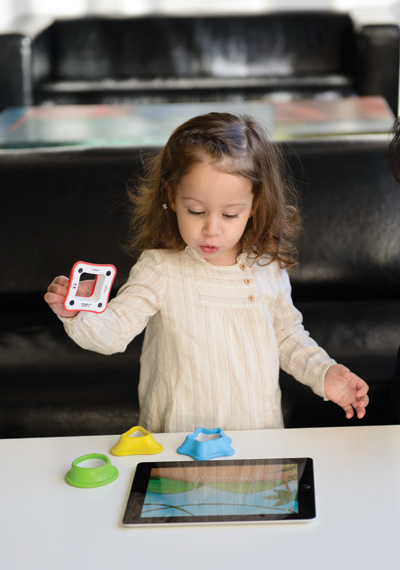
Photo courtesy of Tiggly.com.
This July article is an expanded version of “Weaving Together Touch and Digital into Early Childhood Play” that ran on May 21, 2014.
Azadeh Jamalian has spent four years studying how three- and four-year-olds learn math—using adults as her lab rats. Videotaping adults as part of her PhD work at Columbia University, she found that as the subjects worked through problems, hand gestures were key. The harder the problems, the more they moved their hands. And the more they moved their hands, the more accurate their problem-solving.
Using our hands, Jamalian realized, is crucial to learning—and something slightly missing in the 2-D world of flatscreens, where kids primarily swipe and tap. So Jamalian, the co-founder and chief learning officer of interactive toy and app maker Tiggly, is working to incorporate more physical components into PreK apps.
“The whole premise of manipulating and playing with real objects is a big part of a child’s learning process,” says the New York–based Jamalian. “There is a lot of learning in this interaction that is missing from play on digital devices. At the same time, digital play can be beneficial by giving [kids] feedback and scaffolding. So we’re trying to combine them for the best possible experience.”
Touching is how many young children learn to count, and studies show that this touch interaction is mapped in the human brain. Although kids tend to grow out of counting on fingers, a part of the brain corresponding to finger movement fires when they count in their head later, according to a 2012 study, “You Can Count on the Motor Cortex,” by lead author Nadja Tschentscher, a researcher at the University of Cambridge, published in Neuroimage.
The rise of digital devices in the early childhood arena potentially limits children’s opportunities to learn about the world around them through touch. Members of the British Association of Teachers and Lecturers (ATL) have found that three- and four-year-olds have trouble using toys and blocks because of their overuse of touch-screen devices, according to coverage of ATL’s annual conference in April 2014 published in The Telegraph.
Mindy Brooks, director of education and research at Sesame Workshop, has been assessing how digital screens used with blocks can educate while supporting more organic, physical play. The company already has games that children can play through Microsoft’s Kinect. A new research project, Grover’s Block Party, launched in fall 2013, asks parents to videotape kids playing with blocks while a digital Grover talks about the object, knowing which one the child has picked. Children aren’t directed—they choose how they want to play. The digital element, Grover, keeps up and interacts.
“It’s tricky designing for motor movement with an app on a screen,” says Brooks. “We don’t allow a child to shake or tilt a tablet. We don’t want them shattering. But children come with the expectation of play with an app on screen and off, and it’s challenging to do that right now.”
Tiggly recently launched Tiggly Shapes & Apps (pictured), where children ages eighteen months to four years play with a circle, square, star, and triangle along with an app. The goal is to have children manipulate and roll the shapes, things they can’t do as easily with shapes on a screen. This exercise would address some of the concerns reportedly expressed by ATL members about screen-savvy children who are all thumbs. Jamalian believes game and app developers should look more closely at weaving both online and offline elements into preschool products, as interactivity is core to the learning process.
“We think physical play is important for spatial learning,” she says. “Manipulation of objects plays a big role in how we imagine different things. Just dragging or tapping is not as effective as hand rotating or touching different textures—experiences you can’t have on a screen.” So “we’re trying to combine them for the best learning and growth experience possible.”


